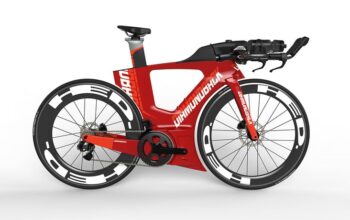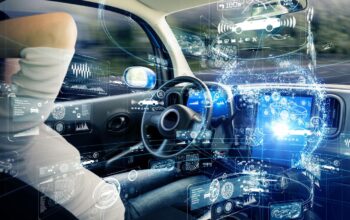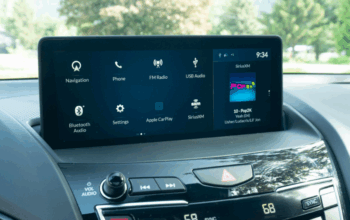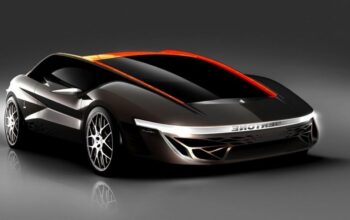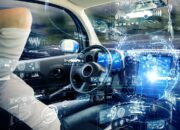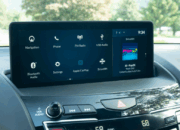The automobile has undergone a profound transformation. Beyond merely transporting us from point A to point B, modern vehicles are evolving into sophisticated, connected ecosystems, with the interior becoming the epicenter of this revolution. We are rapidly moving from a purely mechanical experience to an integrated digital environment, where the boundaries between our cars, our homes, and our digital lives are blurring. This article explores the dawn of the smart vehicle interior, delving into the technologies driving this change, the benefits it offers, the challenges it presents, and what the future holds for our in-car experience.
The Evolution of the Automotive Interior
For decades, car interiors focused primarily on functionality and basic comfort. Seats, steering wheel, pedals, and a rudimentary dashboard constituted the core. Over time, features like air conditioning, power windows, and basic audio systems became standard. The 21st century, however, ushered in an era of rapid technological advancement that began to fundamentally reshape this space.
Early innovations included:
A. Improved Infotainment Systems: Moving from simple radios to CD players, then eventually touchscreens with navigation. B. Enhanced Safety Features: Airbags and basic antilock braking systems became widespread. C. Increased Comfort Amenities: Heated seats, climate control, and more ergonomic designs became common.
Now, we’re witnessing a paradigm shift. The interior is no longer just a place to sit; it’s a third living space—a mobile office, an entertainment hub, a personal assistant, and a sanctuary. This change is driven by a confluence of factors, including advancing sensor technology, artificial intelligence, ubiquitous connectivity, and evolving consumer expectations.
Core Technologies Shaping Smart Interiors
The intelligent automotive interior is built upon a foundation of cutting-edge technologies that work in concert to create a seamless, intuitive, and personalized experience.
A. Advanced Infotainment Systems
Modern infotainment systems are the central nervous system of the smart interior. They are far more powerful than their predecessors, boasting:
- Large, High-Resolution Displays: Often multiple screens, including a central touchscreen, digital instrument clusters, and even displays for rear passengers. These offer crisp visuals and intuitive interfaces.
- Operating Systems: Running sophisticated operating systems (like Android Automotive OS or custom Linux-based systems) that support app ecosystems, over-the-air (OTA) updates, and deep integration with vehicle functions.
- Seamless Smartphone Integration: Apple CarPlay and Android Auto have become standard, mirroring smartphone interfaces and apps directly onto the car’s display. This allows drivers to safely access navigation, music, and communication tools.
- Cloud Connectivity: Enabling real-time traffic updates, streaming services, remote diagnostics, and synchronized data across devices.
B. Artificial Intelligence and Voice Assistants
AI is no longer confined to smartphones or smart speakers; it’s deeply embedded in the vehicle. Voice assistants are becoming incredibly sophisticated, allowing drivers and passengers to control various vehicle functions, navigate, make calls, and access information using natural language commands.
- Natural Language Understanding (NLU): These systems can understand nuanced commands, not just specific keywords.
- Personalization: AI learns user preferences over time, adapting climate settings, music choices, and navigation routes.
- Predictive Capabilities: AI can anticipate needs, suggesting routes based on traffic patterns or recommending charging stations for electric vehicles.
- In-Car Commerce: Imagine ordering coffee or paying for fuel directly from your car using voice commands.
C. Enhanced Connectivity: 5G and Beyond
The rollout of 5G connectivity is a game-changer for smart vehicle interiors. Its high bandwidth and low latency enable:
- Real-time Data Exchange: Critical for autonomous driving systems, real-time traffic updates, and vehicle-to-everything (V2X) communication.
- High-Quality Streaming: Allowing passengers to stream movies, play online games, and conduct video calls without buffering.
- Over-the-Air (OTA) Updates: Enabling manufacturers to push software updates, new features, and security patches to vehicles remotely, much like a smartphone. This extends the vehicle’s lifespan and keeps it current.
- Enhanced Diagnostics: Allowing remote monitoring and proactive maintenance, reducing downtime.
D. Advanced Sensor Technology and Biometrics
The interior is becoming a sensor-rich environment, gathering data to enhance safety, comfort, and personalization.
- Driver Monitoring Systems (DMS): Cameras and sensors track driver alertness, gaze, and head position to detect distraction or drowsiness, issuing warnings when necessary. This is a critical component for future autonomous driving levels.
- Occupant Monitoring Systems (OMS): These systems can detect the presence of passengers, their size, and even their emotional state. They can optimize airbag deployment, climate control, and entertainment based on occupancy.
- Biometric Authentication: Fingerprint scanners, facial recognition, and even iris scanning are being explored for vehicle access, personalized settings recall, and secure in-car payments.
- Gesture Control: Allowing users to control infotainment or other functions with hand gestures, reducing the need to touch screens or buttons.
E. Augmented Reality (AR) Displays
Augmented reality is transforming head-up displays (HUDs) into immersive navigation and information tools.
- AR Navigation: Projecting virtual arrows onto the road ahead, indicating turn directions directly in the driver’s line of sight.
- Hazard Warnings: Highlighting pedestrians, cyclists, or obstacles directly on the windshield.
- Information Overlay: Displaying speed, vehicle status, and other relevant data in an unobtrusive manner.
AR enhances safety by keeping the driver’s eyes on the road and provides a more intuitive way to consume information.
Benefits of the Smart Vehicle Interior
The integration of these technologies offers a multitude of benefits for drivers, passengers, and even the automotive industry itself.
A. Enhanced Safety
While much of the focus on vehicle safety often centers on active and passive safety systems outside the cabin, the smart interior plays an increasingly vital role.
- Distraction Mitigation: Voice control, gesture control, and well-designed user interfaces reduce the need for drivers to take their hands off the wheel or eyes off the road.
- Driver State Monitoring: AI-powered systems detect fatigue, distraction, or even medical emergencies, alerting the driver or even taking corrective action in autonomous modes.
- Personalized Safety Features: Airbags and seatbelt pretensioners can deploy optimally based on occupant size and position.
- Real-time Alerts: Warnings for road hazards, blind spot detection, and impending collisions can be more effectively communicated through haptic feedback in seats or steering wheels, or via AR displays.
B. Unparalleled Comfort and Personalization
The smart interior is designed to be an extension of the individual, adapting to their preferences and needs.
- Personalized Profiles: Vehicle settings (seat position, climate, mirror angles, music preferences) are automatically adjusted based on driver recognition.
- Adaptive Climate Control: Sensors monitor cabin temperature, humidity, and even individual passenger preferences to create an optimal environment.
- Dynamic Lighting: Ambient lighting can change based on mood, time of day, or driver preference, enhancing the cabin’s atmosphere.
- Health and Wellness Monitoring: Integration with wearables or in-car sensors could monitor vital signs, stress levels, or even provide guided meditation.
C. Seamless Connectivity and Productivity
The car transitions from a disconnected box to a fully integrated node in our digital lives.
- Mobile Office: Passengers (and eventually drivers in autonomous vehicles) can conduct video conferences, access documents, and stay productive on the go.
- Entertainment Hub: High-speed internet access allows for streaming movies, music, and gaming, transforming long journeys.
- Smart Home Integration: Control home devices (lights, thermostat, security systems) directly from the car’s interface.
- In-Car Services: Access to concierge services, remote diagnostics, and predictive maintenance scheduling.
D. New Revenue Streams for Automakers
The smart interior opens up entirely new business models and revenue opportunities for car manufacturers beyond the initial vehicle sale.
- Subscription Services: For features like premium connectivity, advanced navigation, entertainment packages, or even performance upgrades.
- In-Car Commerce: Partnerships with retailers, food delivery services, and fuel providers for direct in-vehicle transactions.
- Personalized Advertising: Delivering relevant ads based on driver behavior or location, with strict privacy controls.
- Data Monetization (Anonymized): Aggregated and anonymized data on driving patterns, traffic, and vehicle performance can be valuable for urban planning, smart city initiatives, and insurance companies.
Challenges and Considerations
Despite the immense potential, the journey to fully integrated smart vehicle interiors is not without its hurdles.
A. Cybersecurity and Data Privacy
As vehicles become more connected and collect vast amounts of personal data, cybersecurity and data privacy become paramount concerns.
- Hacking Risks: A compromised vehicle could lead to loss of personal data, remote control of vehicle functions, or even physical harm. Robust encryption, secure software architectures, and continuous vulnerability assessments are crucial.
- Data Collection and Usage: What data is being collected? How is it stored, used, and shared? Clear consent mechanisms and transparent data policies are essential to build consumer trust. Regulations like GDPR are setting precedents for data protection.
- Software Updates: Ensuring secure and reliable over-the-air updates is vital to patch vulnerabilities and prevent malicious interference.
B. User Interface (UI) and User Experience (UX) Design
Creating an intuitive, non-distracting, and enjoyable user experience in a car is incredibly complex.
- Cognitive Load: Too much information or too many options can overwhelm the driver and lead to distraction. Designers must prioritize critical information and simplify interactions.
- Ergonomics and Haptics: Physical controls, touchscreens, and voice commands must be seamlessly integrated. Haptic feedback can provide tactile confirmation without requiring visual attention.
- Personalization vs. Over-Complication: While personalization is key, too many customizable options can be daunting for users. The challenge is to offer flexibility without sacrificing simplicity.
- Standardization: The lack of industry-wide standards for in-car interfaces can lead to fragmented experiences across different vehicle brands.
C. Cost and Accessibility
The advanced technologies discussed come with a price tag, potentially making smart interiors exclusive to premium vehicles.
- Affordability: Democratizing these technologies to make them accessible across various vehicle segments is a challenge.
- Digital Divide: Ensuring that drivers in all regions have access to reliable connectivity to fully utilize smart features.
- Repairability and Longevity: The increasing complexity of in-car electronics raises concerns about long-term reliability, repair costs, and software obsolescence.
D. Regulatory Landscape
Governments and regulatory bodies are playing catch-up with the rapid pace of automotive innovation.
- Safety Regulations: How to regulate driver monitoring systems, autonomous features, and the potential for distraction from large screens.
- Data Privacy Laws: Establishing clear guidelines for data collection, storage, and sharing by vehicles.
- Liability: Determining liability in cases involving autonomous features or software glitches.
E. Human-Machine Teaming in Autonomous Vehicles
As vehicles become more autonomous, the relationship between human and machine within the interior will fundamentally change.
- Trust and Disengagement: How do humans maintain alertness and intervene effectively when the vehicle is driving itself?
- Handover Protocols: Seamless and safe transitions between autonomous driving and human control are critical.
- Designing for Non-Driving Activities: How does the interior adapt when the driver becomes a passenger, allowing for relaxation, work, or entertainment?
The Future of the Smart Vehicle Interior
Looking ahead, the smart vehicle interior will continue its rapid evolution, driven by emerging technologies and shifting societal needs.
A. Full Integration with the Digital Ecosystem
The car will become a true extension of our smart homes, smart offices, and smart cities.
- Seamless Hand-off: Starting a task on your home computer, continuing it on your car’s screen, and finishing it on your office desktop.
- Predictive Personal Assistants: An AI assistant that knows your schedule, preferences, and even emotional state, proactively adjusting the cabin environment and suggesting actions.
- Vehicle-to-Home (V2H) and Vehicle-to-Grid (V2G): Electric vehicles interacting with home energy systems and the power grid for optimized energy management.
B. Modular and Reconfigurable Interiors
As autonomous driving progresses, the need for a fixed driver’s cockpit diminishes. Interiors could become modular and reconfigurable.
- Swiveling Seats: Allowing passengers to face each other for conversations or work.
- Retractable Controls: Steering wheels and pedals could retract when not needed, freeing up space.
- Transformable Spaces: Interiors that can convert from a mobile office to a lounge, or even a sleeping area, with adaptable lighting, sound, and screen configurations.
C. Health and Wellness Focus
The car could become a proactive participant in monitoring and improving our well-being.
- Advanced Health Sensors: Non-invasive sensors in seats or steering wheels could monitor heart rate, blood pressure, and stress levels, alerting occupants to potential issues.
- Therapeutic Environments: Personalized lighting, sound, and scent systems designed to reduce stress, improve focus, or enhance relaxation.
- Personalized Fitness and Rehabilitation: Guided exercises or stretches for long journeys, or even rehabilitation support for individuals with mobility challenges.
D. Immersive Entertainment and Education
Beyond simple streaming, the interior could offer truly immersive experiences.
- Full-Cabin Projection: Using the entire interior as a display surface for movies, games, or virtual tours.
- Interactive Learning: Educational content adapting to passengers’ interests and learning styles during transit.
- Holographic Displays: Projecting 3D images and interfaces within the cabin for more intuitive interaction.
E. Sustainable and Biometric Materials
The choice of materials in smart interiors will also evolve, focusing on sustainability and enhanced functionality.
- Recycled and Bio-based Materials: Reducing the environmental footprint of vehicle manufacturing.
- Self-Healing Materials: Interior surfaces that can repair minor scratches or blemishes.
- Smart Fabrics: Textiles with integrated sensors for health monitoring, haptic feedback, or dynamic lighting.
Conclusion
The transformation of the automotive interior is not just about adding more screens or voice commands; it’s about fundamentally rethinking how we interact with our vehicles and how these vehicles integrate into our broader digital lives. The smart vehicle interior is set to become a highly personalized, deeply connected, and incredibly versatile space, offering enhanced safety, comfort, and productivity.
While challenges related to cybersecurity, data privacy, and user experience design remain, the relentless pace of technological innovation, coupled with evolving consumer demands, ensures that the vehicle cabin will continue its metamorphosis. The “New Era: Smart Vehicle Interiors” signifies a future where our cars are more than just machines; they are intelligent, adaptable partners in our daily journeys, profoundly enriching our mobility experience and blurring the lines between transportation and living space. Get ready for a future where your car knows you, adapts to you, and connects you like never before.






